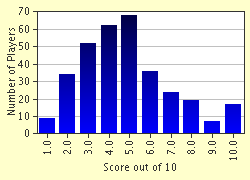Quiz Answer Key and Fun Facts
1. From which generic type of cloud do thunderstorms/tornados come from?
2. What does an isohyet represent?
3. According to the Beaufort scale, what wind speed (in knots) is deemed to be a fresh breeze?
4. Can steam fog form when warm air moves over cold water?
5. What is the term for an anticlockwise change in wind direction without an alteration in strength?
6. The Dry Adiabatic Lapse Rate (DALR) is approximately equal to?
7. What is CAPE?
8. What type of cloud would be more to likely give showers of precipitation reaching the ground?
9. The lowest 100km of the atmosphere is divided into four parts. What is the correct order from the ground up?
10. Which of these is a formation requirement of a tropical cyclone (hurricane)?
Source: Author
wallos
This quiz was reviewed by FunTrivia editor
crisw before going online.
Any errors found in FunTrivia content are routinely corrected through our feedback system.


